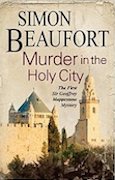
The First Sir Geoffrey Mappestone Mystery
Holding on to the Kingdom of Jerusalem after the First Crusade was difficult enough, but suddenly a series of murders threatens the entire security of the City.
In 1097 the Pope appealed to all virtuous and God-fearing men to join the Crusade to wrest Jerusalem from the Infidel. But by 1100, Sir Geoffrey Mappestone is one of the few knights who has survived the harrowing journey, the battle to take the city, and the political infighting over the rule of the kingdom.
Upon returning to Jerusalem one day following an exhausting desert patrol, Geoffrey hears screams coming from the house of a Greek baker and discovers that one of his closest friends, a fellow knight, has been murdered in the woman’s bedchamber. But this is not the first suspicious death in the city – other knights and priests have also been killed, and all, it is discovered, with the same type of curved dagger with a jewelled hilt.
Ordered to investigate the deaths by his liege lord, Prince Tancred, Geoffrey realises too late that they are somehow part of a plot to topple the most formidable lords from their uncertain hold on power. It is not long before he finds himself drawn into dire straits involving some of the most dangerous men in the city – and learns that his closest friends could also be his deadliest enemies.
Amazon.co.ukHardcoverKindle EditionWaterstoneseBook
Amazon.comUS HardcoverUS Kindle Edition
Extract
The Tower was always rowdy, as would be expected in a building filled with warriors, and even now, in the depths of the night, there were guffaws of laughter and triumphant shouts from some illicit game of dice. Geoffrey, being relatively senior in the citadel hierarchy because of the regard in which his liege lord Prince Tancred held him, had his own chamber, a tiny, cramped room in the thickness of the wall overlooking David’s Gate. It served Geoffrey as an office as well as a bedchamber, and, on occasion, even as a hospital if one of his men were ill and needed rest away from the smelly, crowded conditions of the tents in the outer bailey.
Gratefully, he pushed open the stout wooden door and stepped inside. It was dark, and only the faint shaft of silver moonlight glimmering through the open window offered any illumination. The room was sparsely furnished: a truckle bed that could be rolled up and moved into the short corridor that led to the garderobe; a long bench against one wall; and a chest that held spare bits of armour, some clothes, his beloved books, and some less intellectual loot from Nicaea. His dog, stretched out in front of the window to take advantage of the breeze, looked up lazily as Geoffrey entered. It gave a soft, malevolent growl, and went back to sleep.
Without bothering to light the candle that was always set on the windowsill, Geoffrey unbuckled his surcoat and removed the mail shirt, hanging both carefully on wall pegs. No warrior who valued his life failed to take good care of the equipment that might save it. He tugged off his boots and, clad in shirt and hose, wearily flopped down on the bed.
And immediately leapt up again.
‘God’s teeth!’
Pinned to the wall above his head was a heart, dark with a crust of dried blood. And it was held there by a curved dagger with a jewelled hilt.

